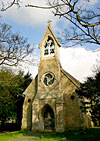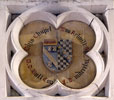 Barnstone Barnstone
St Mary
History
St Mary’s, Barnstone, is not mentioned in Domesday Book.
Under the heading Langar, Barnstone and St Aubrey’s in Antiquities of Nottinghamshire Thoroton described ‘an ancient Church, or Chapel, in the Fields of Langar, called St. Athel-burga's, or St. Aubrey's’. White’s Directory of Nottinghamshire (1832 and 1853 editions) suggested that St Mary’s, Barnstone was a successor of this ancient chapel. However in Notes on the Churches of Nottinghamshire J. T. Godfrey treats Langar parish church, St Mary’s Barnstone and St Aubrey’s as three separate churches.
The Rampton Tapestry map provides evidence for the church of St Aubrey’s, also called St Ambrose’s, having been in existence at least until 1632. The tapestry map depicts the county of Nottinghamshire and includes a large church labelled ‘St Ambrose’ south of Barnstone. The tapestry is dated 1632 and carries the words ‘At Rampton made we were/ By Mistress Mary Eyre’.
An ordinance from 1231 by the Archbishop of York describes a dispute involving Barnstone chapel. From this ordinance we know that Barnstone chapel predates 1215, because the dispute involved a chantry held in the chapel three days a week before the 1215 Lateran Council. At this time, Langar and Barnstone were linked together in official records, the Liber Feodorum notes that in 1226-8 Radulph de Rodes held the villages together at a clear annual value of £40.
In the reign of Edward III, an inspeximus confirmed that Thurgarton Priory held interests in Barnstone, notably one bovate of land with appurtenances, a toft, and a further three bovates plus two acres of meadow land in Barnstone and Wyverton.
In June 1336 Archbishop William Melton held a visitation to several churches in the Bingham deanery and on Tuesday 11 June he visited Barnstone (Berneston) chapel. The outcome of his visit is not recorded.
Barnston chapel is included in an inventory of church goods made in the reign of Edward VI (1461-70, 1471-83). The chapel was linked to the church of Langar in this record. It recorded:
‘ffirst one challis of Silver with a cover for the same. Also one vestment of Rede Scamell. Also one crosse of bras. Also one cruet. Also ij alt clothes. Also ij towels. Also ij bells. Also j candlestick of bras that standeth of the alter. Also one surplus wtslevis.’
Marriages solemnised in Barnstone chapel between 1614 and 1715 are recorded in the Langar parish register.
Barnstone chapel is also mentioned in the records of Parliamentary commissions of 1650. The incumbent of the rectory of Langar cum Barnstone was John Featley Clarke. The curate was Zachery Cawdrey Clerke, described as ‘an able preacher who preaches twice every lord’s day, once at Langar the parishe churche and once at Barnston the Chapell belonging to the said Church’.
Instructions to the churchwardens from the archdeacon’s court in 1688 give some information about the condition of St Mary’s. These instructions were part of a wider drive throughout the Church of England to make sure that church buildings were in good order and repair. The instructions noted that there was no communion rail, chapel yard, pulpit cloth or cushion.
In 1764 Archbishop Drummond toured the diocese. Barnstone chapel was described in the records of this visitation as part of the entry on Langar with Barnstone. The vicar wrote;
Barnstone chapel is annexed to the church of Langar and situated about a measured mile from it. I preach there every third Sunday at least and administer the sacrament on Good Friday. The chapel is old, and notwithstanding the people of Barnstone, or rather seven farmers of the place, are at a good deal of expense about it, the chapel is sinking and cannot stand long. It is indeed of little use; because there is no burying ground nearer than the mother church; and the people have good seats there, which are well filled by the inhabitants of Barnstone every Sunday.
St Mary’s was mentioned in the 1851 religious census. The chapelry of Barnstone was recorded as part of the parish of Langar. Afternoon services were held every other Sunday at Barnstone, alternating with Langar church.
 The majority of the present structure of St Mary’s dates from 1856, when the old chapel was largely rebuilt. Thomas Dickinson Hall, a local landowner, funded the rebuilding, which cost £1,200. His generosity is commemorated in the building; above the entrance in quatrefoil is inscribed ‘This chapel was rebuilt by T D Hall Esq. MDCCCLVI’. The 1864 White's Directory described the new chapel as a ‘neat edifice in the Decorated style’. The majority of the present structure of St Mary’s dates from 1856, when the old chapel was largely rebuilt. Thomas Dickinson Hall, a local landowner, funded the rebuilding, which cost £1,200. His generosity is commemorated in the building; above the entrance in quatrefoil is inscribed ‘This chapel was rebuilt by T D Hall Esq. MDCCCLVI’. The 1864 White's Directory described the new chapel as a ‘neat edifice in the Decorated style’.
The chapel contains 15 coats of arms. One of these, the coat of arms of Fairclough of Lancashire, was found in the old chapel when it was rebuilt.
St Mary’s was listed in the records of the visitation of Sir Edwyn Hoskyns, Bishop of Southwell. He toured the diocese in 1912. The Rector of Langar with Barnstone was D. F. Wright. The benefice was worth £210. The population of the parish of Langar with Barnstone in 1911 was 453. Barnstone chapel could accommodate 100 people and 20 children were on the Sunday School roll.
Roll of honour lists were installed in the church to commemorate those of the parish who died in WWI and WWII.
St Mary’s, Barnstone is now part of the Wiverton group of churches.
| 




